Possible Interactions between Invasive Caulerpa Taxa and Native Macrozoobenthos: The Case Study of Favignana Island
Abstract
Author Contributions
Funding
Institutional Review Board Statement
Informed Consent Statement
Data Availability Statement
Acknowledgments
Conflicts of Interest
References
- Streftaris, N.; Zenetos, A. Alien marine species in the Mediterranean—The 100 worst invasives and their impact. Mediterr. Mar. Sci. 2006, 7, 87–118. [Google Scholar] [CrossRef]
- Zenetos, A.; Galanidi, M. Mediterranean non-indigenous species at the start of the 2020s: Recent changes. Mar. Biodivers. Rec. 2020, 13, 10. [Google Scholar] [CrossRef]
- Occhipinti-Ambrogi, A.; Marchini, A.; Cantone, G.; Castelli, A.; Chimenz, C.; Cormaci, M.; Froglia, C.; Furnari, G.; Gambi, M.C.; Giaccone, G.; et al. Alien species along the Italian coasts: An overview. Biol. Invasions 2010, 13, 215–237, Erratum in Biol. Invasions 2010, 13, 531–532. [Google Scholar] [CrossRef]
- Katsanevakis, S.; Coll, M.; Piroddi, C.; Steenbeek, J.; Lasram, F.B.R.; Zenetos, A.; Cardoso, A.C. Invading the Mediterranean Sea: Biodiversity patterns shaped by human activities. Front. Mar. Sci. 2014, 1, 32. [Google Scholar] [CrossRef]
- Mannino, A.M.; Balistreri, P.; Yokeş, M.B. First record of Aplysia dactylomela (Opisthobranchia: Aplysiidae) from the Egadi Islands (western Sicily). Mar. Biodivers. Rec. 2014, 7, E22. [Google Scholar] [CrossRef]
- Mannino, A.M.; Parasporo, M.; Crocetta, F.; Balistreri, P. An updated overview of the marine alien and cryptogenic species from the Egadi Islands Marine Protected Area (Italy). Mar. Biodivers. 2016, 47, 469–480. [Google Scholar] [CrossRef]
- Mannino, A.M.; Gambi, M.C.; Dieli, T.; Gianguzza, P. A new contribution to the alien macroalgal flora of the Ustica Island Marine Protected Area (Tyrrhenian Sea, Italy). BioInvasions Rec. 2018, 7, 367–373. [Google Scholar] [CrossRef]
- Mannino, A.M.; Cicero, F.; Toccaceli, M.; Pinna, M.; Balistreri, P. Distribution of Caulerpa taxifolia var. distichophylla (Sonder) Verlaque, Huisman & Procaccini in the Mediterranean Sea. Nat. Conserv. 2019, 37, 17–29. [Google Scholar] [CrossRef]
- Boudouresque, C.F.; Meinesz, A.; Ribera, M.A.; Ballesteros, E. Spread of the green alga Caulerpa taxifolia (Caulerpales, Chlorophyta) in the Mediterranean: Possible consequences of a major ecological event. Sci. Mar. 1995, 59 (Suppl. S1), 21–29. [Google Scholar]
- Klein, J.; Verlaque, M. The Caulerpa racemosa invasion: A critical review. Mar. Pollut. Bull. 2008, 56, 205–225. [Google Scholar] [CrossRef] [PubMed]
- Mannino, A.M.; Balistreri, P. Citizen science: A successful tool for monitoring invasive alien species (IAS) in Marine Protected Areas. The case study of the Egadi Islands MPA (Tyrrhenian Sea, Italy). Biodiversity 2018, 19, 42–48. [Google Scholar] [CrossRef]
- Mannino, A.M.; Balistreri, P. Invasive alien species in Mediterranean Marine Protected Areas: The Egadi Islands (Italy) case study. Biodiversity 2021, 22, 13–23. [Google Scholar] [CrossRef]
- Gianguzza, P.; Bonaviri, C.; Zava, B.; Monteverde, G.; Riggio, S. Spread of Caulerpa taxifolia (Caulerpales, Ulvophyceae) along the coasts of Favignana Island. Biol. Mar. Medit. 2006, 13, 182–183. [Google Scholar]
- Gianguzza, P.; Zava, B.; Bonaviri, C.; Monteverde, G.; Palmeri, A.; Riggio, S. First record of Caulerpa taxifolia (Caulerpales, Ulvophyceae) in the western Sicilian waters (Italy). Biol. Mar. Medit. 2006, 13, 591–592. [Google Scholar]
- Miccoli, A.; Mancini, E.; Boschi, M.; Provenza, F.; Lelli, V.; Tiralongo, F.; Terlizzi, A.; Bonamano, S.; Marcelli, M. Trophic, chemo-ecological and sex-specific insights on the relation between Diplodus sargus (Linnaeus, 1758) and the invasive Caulerpa cylindracea (Sonder, 1845). Front. Mar. Sci. 2021, 8, 680787. [Google Scholar] [CrossRef]
- Rizzo, L.; Vega Fernández, T. Can the invasive seaweed Caulerpa cylidracea represent a new trophic resource in the Mediterranean Sea? Water 2023, 15, 2115. [Google Scholar] [CrossRef]
- Terlizzi, A.; Felline, S.; Lionetto, M.G.; Caricato, R.; Perfetti, V.; Cutignano, A.; Mollo, E. Detrimental physiological effects of the invasive alga Caulerpa racemosa on the mediterranean white seabream Diplodus sargus. Aquat. Biol. 2011, 12, 109–117. [Google Scholar] [CrossRef]
- Felline, S.; Mollo, E.; Cutignano, A.; Grauso, L.; Andaloro, F.; Castriota, L.; Consoli, P.; Falautano, M.; Sinopoli, M.; Terlizzi, A. Preliminary observations of caulerpin accumulation from the invasive Caulerpa cylindracea in native Mediterranean fish species. Aquat. Biol. 2017, 26, 27–31. [Google Scholar] [CrossRef]
- Ruitton, S.; Verlaque, M.; Aubin, G.; Boudouresque, C.F. Grazing on Caulerpa racemosa var. cylindracea (Caulerpales, Chlorophyta) in the Mediterranean Sea by herbivorous fishes and sea urchins. Vie Milieu-Life Environ. 2006, 56, 33–41. [Google Scholar]
- Bulleri, F.; Malquori, F. High tolerance to simulated herbivory in the clonal seaweed, Caulerpa cylindracea. Mar. Environ. Res. 2015, 107, 61–65. [Google Scholar] [CrossRef] [PubMed]
- Boncagni, P.; Rakaj, A.; Fianchini, A.; Vizzini, S. Preferential assimilation of seagrass detritus by two coexisting Mediterranean and sea cucumbers: Holothuria polii and Holothuria tubulosa. Estuar. Coast. 2019, 231, 106464. [Google Scholar] [CrossRef]
- Pasquini, V.; Addis, P.; Giglioli, A.A.; Moccia, D.; Pusceddu, A. Outcomes of feeding activity of the sea cucumber Holothuria tubulosa on quantity, biochemical composition, and nutritional quality of sedimentary organic matter. Front. Mar. Sci. 2023, 9, 1010014. [Google Scholar] [CrossRef]
- Bedini, R.; Canali, M.G.; Bedini, A. Use of camouflaging materials in some brachyuran crabs of the Mediterranean infralittoral zone. Cah. Biol. Mar. 2003, 44, 375–384. [Google Scholar]
- Tanduo, V.; Virgili, R.; Osca, D.; Crocetta, F. Hiding in fouling communities: A native spider crab decorating with a cryptogenic bryozoan in a Mediterranean marina. J. Mar. Sci. Eng. 2021, 9, 495. [Google Scholar] [CrossRef]
- Cruz-Rivera, E. Generality and specificity in the feeding and decoration preferences of three Mediterranean crabs. J. Exp. Mar. Biol. Ecol. 2001, 266, 17–31. [Google Scholar] [CrossRef]
- McLay, C.L. Camouflage by the masking crab, Notomithrax ursus (Herbst, 1788) (Decapoda: Brachyura: Majidae): Is it a decorator or a dressmaker? J. Crust. Biol. 2020, 40, 673–683. [Google Scholar] [CrossRef]
- Woods, C.M.C.; McLay, C.L. Use of camouflage materials as a food store by the spider crab Notomithrax ursus (Brachyura: Majidae). N. Z. J. Mar. Fresh. Res. 1994, 28, 97–104. [Google Scholar] [CrossRef][Green Version]
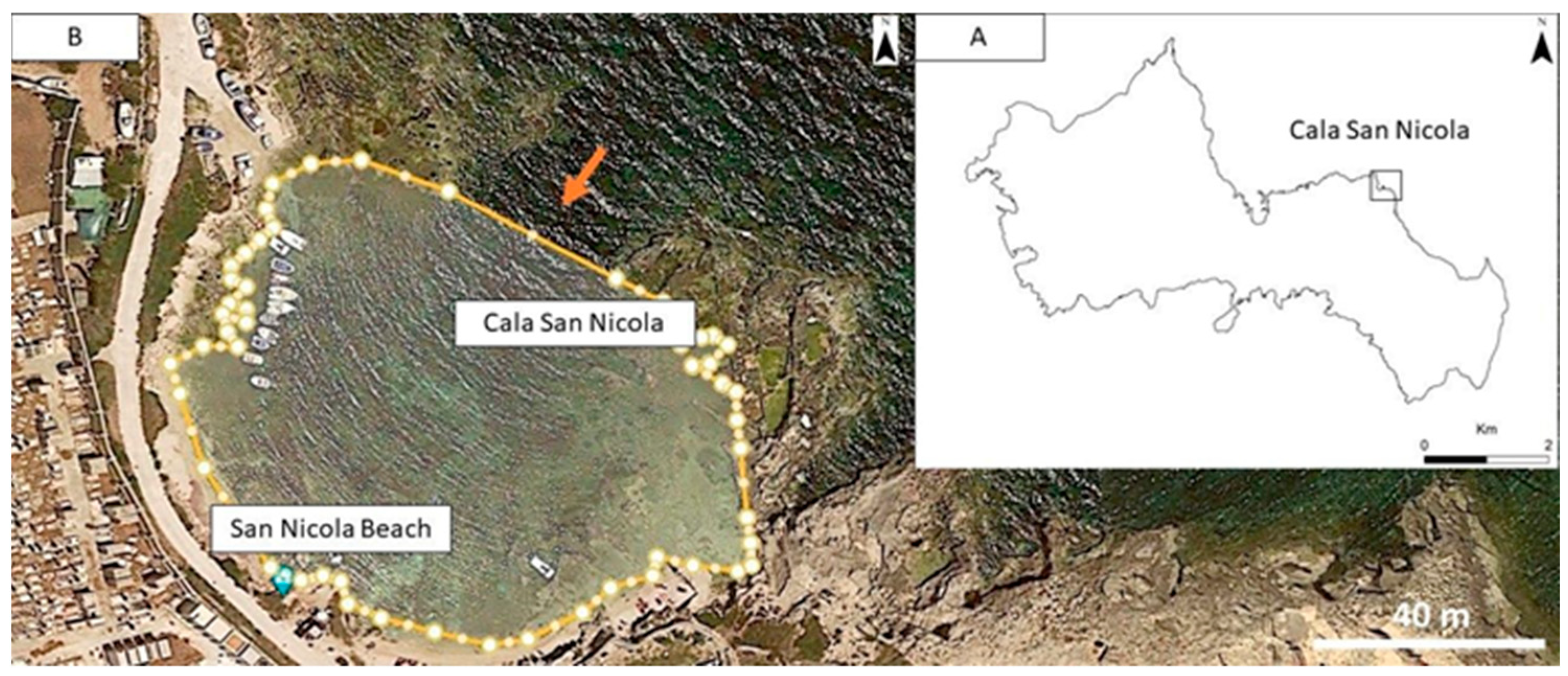
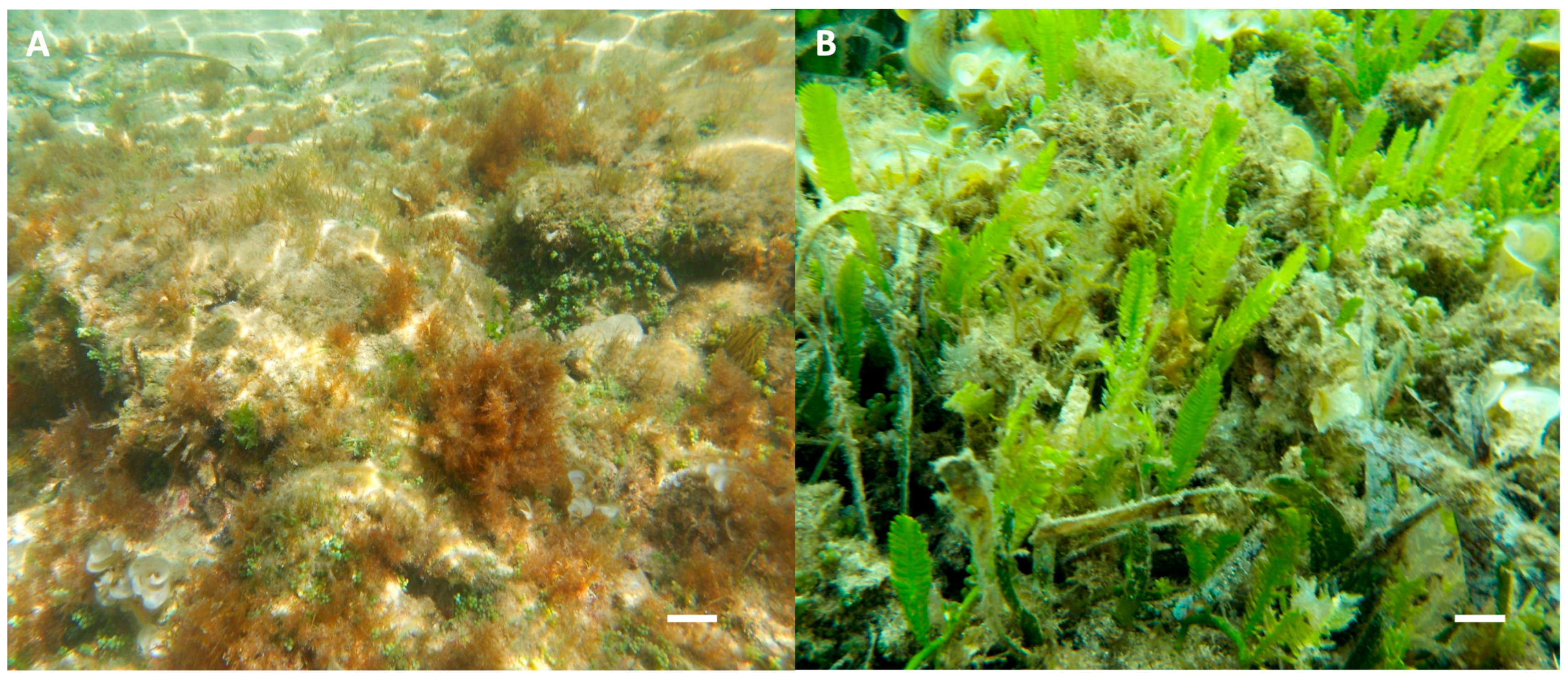
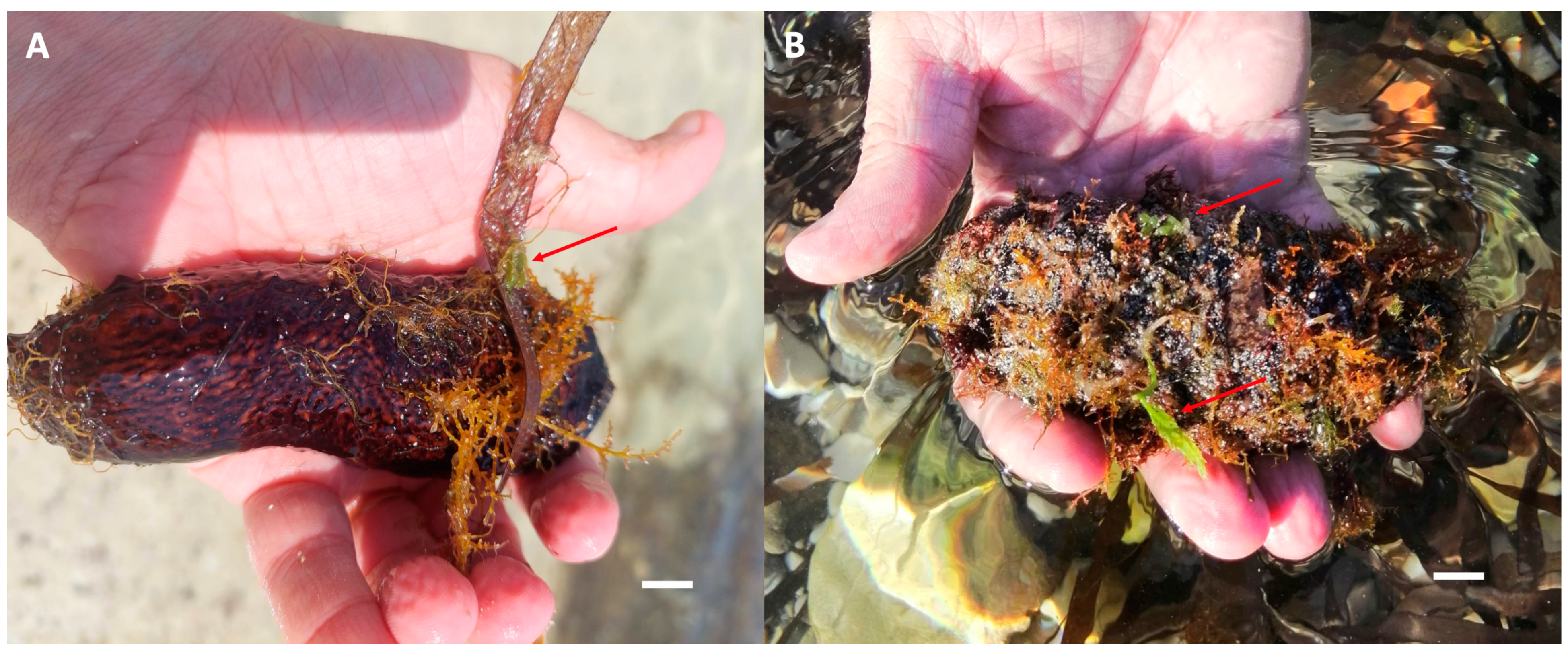
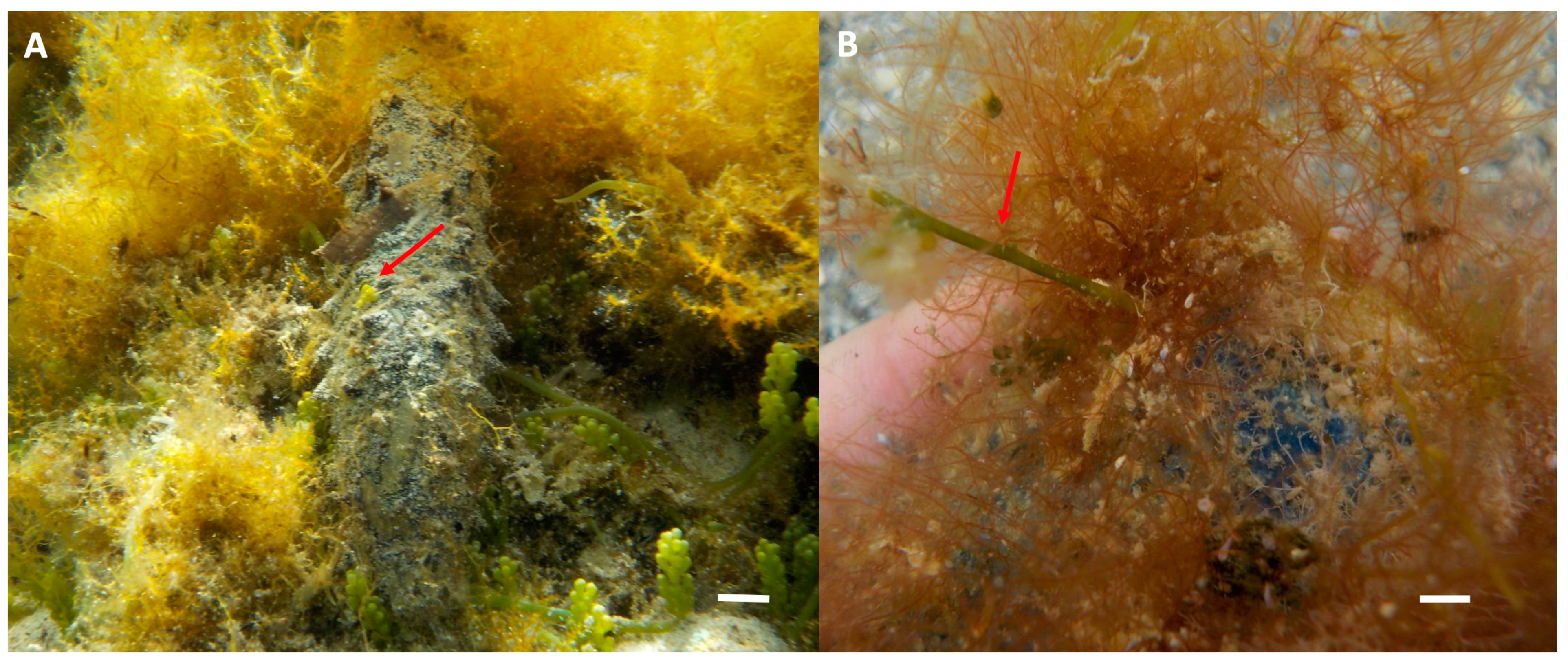
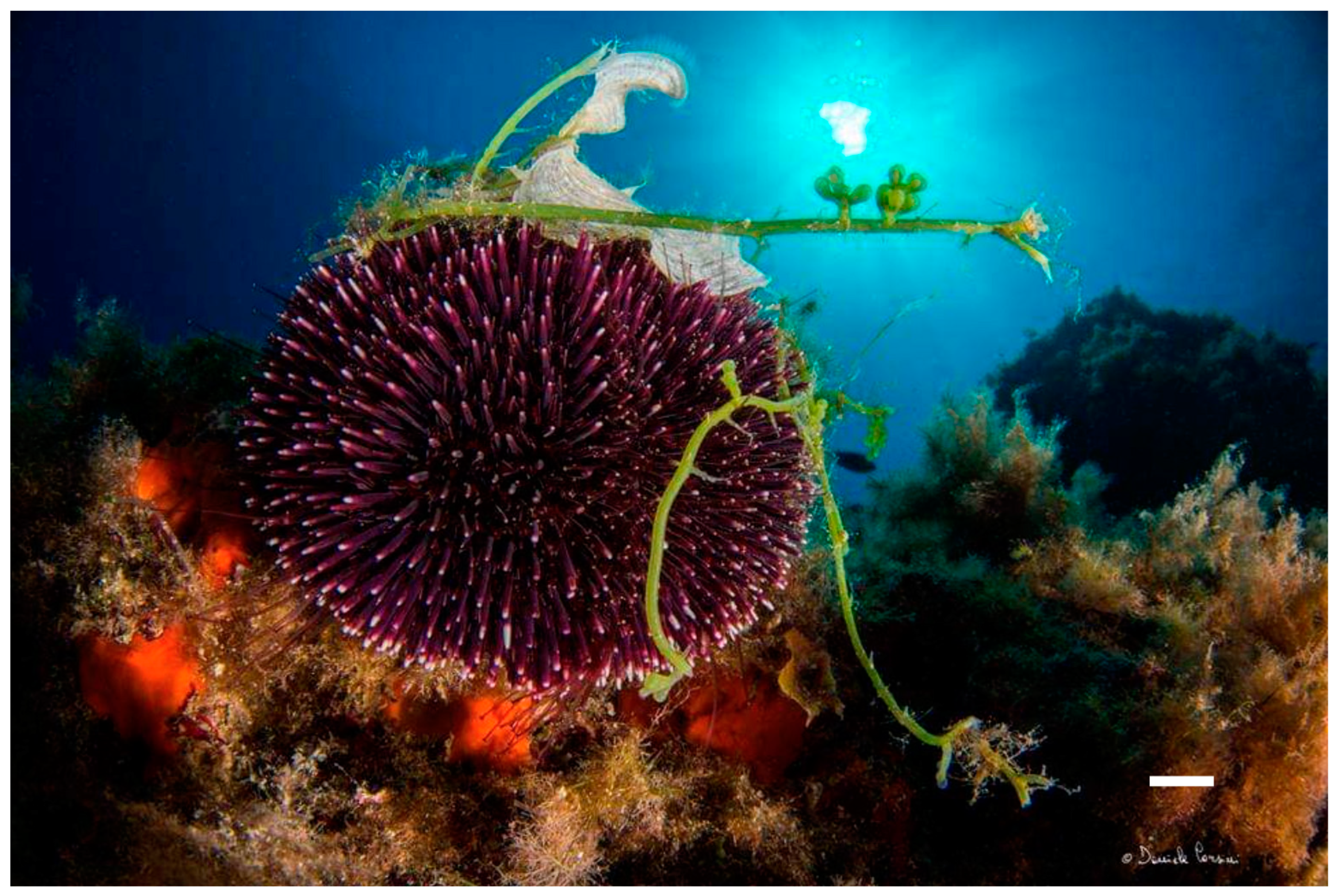
Disclaimer/Publisher’s Note: The statements, opinions and data contained in all publications are solely those of the individual author(s) and contributor(s) and not of MDPI and/or the editor(s). MDPI and/or the editor(s) disclaim responsibility for any injury to people or property resulting from any ideas, methods, instructions or products referred to in the content. |
© 2023 by the authors. Licensee MDPI, Basel, Switzerland. This article is an open access article distributed under the terms and conditions of the Creative Commons Attribution (CC BY) license (https://creativecommons.org/licenses/by/4.0/).
Share and Cite
Mannino, A.M.; Balistreri, P. Possible Interactions between Invasive Caulerpa Taxa and Native Macrozoobenthos: The Case Study of Favignana Island. Diversity 2023, 15, 919. https://doi.org/10.3390/d15080919
Mannino AM, Balistreri P. Possible Interactions between Invasive Caulerpa Taxa and Native Macrozoobenthos: The Case Study of Favignana Island. Diversity. 2023; 15(8):919. https://doi.org/10.3390/d15080919
Chicago/Turabian StyleMannino, Anna Maria, and Paolo Balistreri. 2023. "Possible Interactions between Invasive Caulerpa Taxa and Native Macrozoobenthos: The Case Study of Favignana Island" Diversity 15, no. 8: 919. https://doi.org/10.3390/d15080919
APA StyleMannino, A. M., & Balistreri, P. (2023). Possible Interactions between Invasive Caulerpa Taxa and Native Macrozoobenthos: The Case Study of Favignana Island. Diversity, 15(8), 919. https://doi.org/10.3390/d15080919








